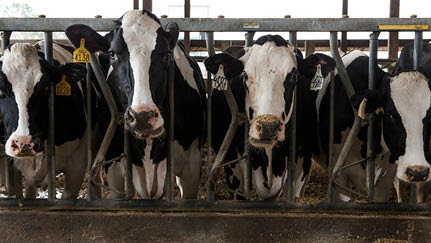U.S. dairy farmers are well-acquainted with challenges, from market volatility to industry consolidation and shifting consumer preferences. Now, a new hurdle has emerged that could transform herd management practices: H5N1 bird flu on dairy farms.
While the virus is lethal to poultry, it poses a significant financial threat to dairy farmers. Bird flu in dairy cattle could necessitate operational changes to prevent or minimize the impact of these disruptions to production.
What is the bird flu?
Federal testing confirmed H5N1 in dairy cows — Highly Pathogenic Avian Influenza (HPAI) H5N1 — in March 2024. The discovery marked a first, the zoonotic transmission of the virus from birds to dairy cattle and later, farm workers. The virus normally infects domestic and wild bird species. It’s “highly contagious” and often fatal for birds. It’s rarely fatal for cattle and humans and often limited to flu-like symptoms, but other animals — namely hogs — may be more susceptible to severe, potentially mortal symptoms. That’s got a lot of attention on how dairy farmers respond to the bird flu threat.
How does bird flu affect dairy farms?
For dairy farmers, the bird flu can cause financial losses from:
- Decreased milk production and the inability to meet contracted milk deliveries
- Higher production costs
- Costs to add biosecurity measures to a farm
- Replacing cows lost or that see sharp declines in milk output
“While dairy cows that have been infected with H5N1 generally recover well, it does dramatically limit milk production, causing financial losses for producers with affected premises,” according to a USDA report.
How to protect dairy cows from H5N1
Those losses — and the costs dairy farmers may incur to test for and slow or stop the spread of H5N1 — were the motivation behind USDA expanding dairy farmer support in the wake of the virus. Historically, dairy farms don’t have the biosecurity measures in place that are more common on poultry and hog farms.
“This is a real wake-up call that we have to be more diligent with biosecurity. You can’t even go into a hog farm today without showering in first,” said Nationwide Senior Dairy Consultant Dan Rice. “On most dairy farms, you don’t even have to sanitize your boots. We need to be more mindful of biosecurity by adding things like this to our farms.”
Minimizing farm entry points and limiting access to only workers, veterinarians and other essential people can help keep the virus away from a dairy farm.
“Hauling cattle from multiple farms to a sale barn, for example, is one way to spread the virus easily. You can help prevent this risk by locating a loading area where you can move cattle so a truck isn’t driving onto your main farm,” Rice said. “I have seen dairy farms with five entry points. That makes it extremely difficult to control access. Though it’s not always easy, one entry point is ideal.”
Create a ‘culture of safety’ for bird flu
These steps — on top of regular herd health monitoring, securing feed from reliable suppliers and creating a plan for if the bird flu does show up on your farm — can help farmers be ready. That readiness will go a long way to keeping the virus away from not just dairy cows but other livestock like hogs that may be more endangered by the bird flu.
“Create a culture of safety to keep your farm safe for your families and workers,” Rice said. “In the case of H5N1, that culture needs to be about safety and biosecurity to prevent the disease from spreading.”
Rice recommends making sure you’re in regular contact with your veterinarian in case testing becomes necessary. It’s also a good idea to stay in touch with your risk management partner. Talk to your Nationwide Farm Certified agent to see what you can do to build a culture of safety on your dairy farm.
